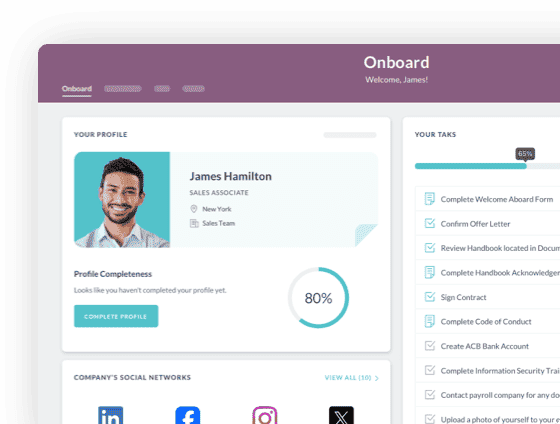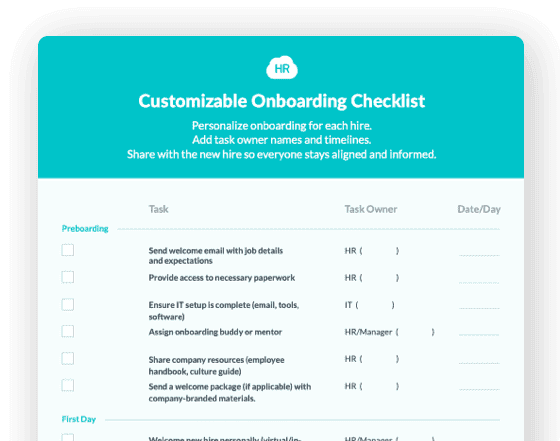Gamification is HR's Best Friend-Why Should Employees Play Games?
.jpg)


 Cut onboarding time
by 60%—here's the
Ultimate Checklist
that helped do it.
Cut onboarding time
by 60%—here's the
Ultimate Checklist
that helped do it.

Gaming in the workplace? Sounds silly, doesn’t it? Except it really isn’t a far-fetched idea anymore. Employers are moving towards flexible and diverse working environments. The pandemic situation has also made the workforce accustomed to working from home online and in casual environments.
What is Gamification?
Gamification is the process of introducing game rules and dynamics into a professional environment to increase employee productivity and efficiency to get on the leader board. Quite recently, tech giants like Google and Microsoft have started to introduce global 2000 gamification into their workplaces.
Gamification introduces healthy competition in the workplace by introducing game-like principles of points, rewards, and scoreboards, etc.
What are the Benefits of Playing Games at Work?
Game mechanics can be used to introduce engagement and learning amongst your employees. Here are a few advantages to introducing games to play at work:
Increase Employee Productivity
Can gaming at work make you more productive? Games promote a collaborative environment and a spirit of teamwork. This is what will help your teams operate better together. You can use game design and dynamics to hone your employees’ skills, and that will also contribute to increased productivity, behavior modification, and efficiency in employees that are more relaxed and comfortable. Then you can track employee’s productivity through the Time Clock by HR Cloud. You will see productivity indicators rise sharply, so as does customer satisfaction.
Increase Motivation in Employees
Gamification uses a rewards and achievements system by assigning specific goals to employees. This can promote healthy competition within teams and team members and keep them motivated for the next stage of learning or goal assessment.
Let’s look at the example of Telus, the telecommunications giant. They improved their engagement rate from 54% to 87% by using role-playing games, video games, and gamification techniques in the workplace. As well their point system is quite demanding.
Encourage Creative Ideas
Being exposed to gaming in the workplace can introduce your employees to new ideas and ways of doing things and solving problems. Giants like Google and Microsoft invest a lot of time in including their workforce in playful activities that inspire creativity. These employees are greatly motivated to show up to their workplace with new ideas and approaches.
Make Communication Stronger
Gaming in the workplace together can improve your employees’ communication skills and their understanding of each other as team members. Better understanding and communication lead to better and quicker work done. As well the social network addiction on the workplace will decrease. If you combine games with the WorkMates program, you will improve not only communication but also the general atmosphere in the team.
Stay in Tune with the Market
Gamification is a new concept and many prospective employees, like millennials and the workforce from Generation Z, are seeking out companies and employers that offer a playful and relaxed environment. As the market is shifting towards more flexible working policies, gamification and related practices will allow you to attract good employees and retain them.
Promote Skill Improvement
Having problems improving the functional competency of your workforce through normal learning methods? Introduce games into the mix and make it competitive. The moment you introduce the concept of gamification to your employees’ learning, You will notice that they’re more motivated and excited about completing the learning milestones and then applying those skills later on.
Are you still wondering: Can games be used in companies for work? Or how to play games at work and for what? If you would ask your employees about games on work space – the answer will be “YES!”. You can even make a table with office gamers and get their electronic signature through HR Cloud. The result will surprise you.
We’ve compiled a list of focus areas where you can use gamification to improve employee engagement and emphasize skills development.
What Areas Can Gamification be Applied to?
Gamification can be used in different departments and areas to improve operations and introduce innovation into your processes. Here is where it’s most applicable:
Customer Support and Services:
Use the achievements and rewards system to incentivize your employees. This will promote better customer service and encourage your employees to help each other out with new ideas and techniques.
Sales
Gaming in the workplace and introducing gamification principles can actually help you improve your sales and revenue. Give your sales team targets that they need to achieve and associate incentives with these targets. This will help you improve the entire sales process.
Encourage Teamwork
Introduce gaming in the workplace and between departments to allow for cross-functional learning and the development of cross-skilled teams. Ford actually introduced gamification in their LMS and saw a 417% increase in its usage.
Human Resources
We think this is one area where gamification and gaming at work can really benefit the company. You can introduce gaming for leadership skills development and performance reviews etc. and introduce healthy competition within teams. Also for the HR team, it is worth purchasing an easy-to-hire program from HR Cloud named Recruit. This program will create a healthy environment, productivity and motivation for the HR team.
Project Management
Games played at work can help teams deliver projects on time and ensure quality. Because game elements increase productivity. Indeed, during games, our brain is distracted from routine tasks, just like on vacation. Of course, like the Time-Off program controls the vacation, you also need to control the time spent playing games. After all, if employees play all day, their productivity is unlikely to increase.
As you can see, gamification can revolutionize the way you do business processes and bank on the basic human need to win to optimize your sales, operations, marketing, accounting, etc. But, what are some games that you can introduce to the workplace to simply lighten the mood and create a playful environment?
Games to Play at Work-Some Examples:
Team Challenges
Faced with a problem you can’t find a solution to? Simply gather the team and bring all that brainpower together. Give your team the challenge to solve this problem. The person who comes up with the most innovative solution gets a reward like paid time off or a bonus.
Play Listening Based Games
Oftentimes, we hear that our teams aren’t able to communicate in the right way. This is because we are all focused on hearing rather than actually connecting information. Do simple listening exercises with the team and train them to look for hidden meanings and communication.
Ice-breakers
Have a set of ice-breaking games for new recruits and even employees in different departments. Have people share their personal stories or a funny situation they’ve been in to break the awkwardness and get people to feel comfortable with each other.
Collaboration based games
Research has suggested that today’s employees work more in collaborative environments than they did 5 years ago. You can focus on simple team-based games like scrabble and other board games where employees can collaborate with the main player and aim for the win. This will strengthen leadership skills and collaborative skills within the team.
Frustration Game
Now, the rules of the game are very interesting as it involves one employee acting very rude and busy while the other is trying to have a conversation with them. They can be using their phone or looking bored while the other employee is trying to find a way to get their point across. This will teach the observing employees that, in order to ensure healthy communication, we have to make sure that we are giving each other our undivided attention.
A Team Scavenger Hunt
You can set up a scavenger hunt for different teams depending on the size of your team. This can include tasks and clues related to work or not. People can go around the office location and look for clues and take pictures as proof of finding the clues.
The team that finds all the clues first wins the hunt. This will be a fun break from the daily monotony of the workplace and allow people to take a breather from their hectic routines.
Do an Advertising Exercise
It’s time to unleash some of that creativity that no one gets to express. Have your employees design an ad that shows their perspective on the company or service you provide. The team with the best ad gets to win in the end. This will introduce some excitement within the team and also help them exercise some of that creativity without any restraint.
Introduce Gaming Hour
Introduce an hour a week where teams can engage in games of their choice. The main rule should be to play games that involve 2 or more players. This will be your team’s respite hour. This doesn’t have to be a virtual game only. You can introduce football or other games into the mix as well.
There you have it. You see how gaming in the workplace can help keep morals high and also ensure that your team learns how to operate as one unit. You will not only encourage healthy discourse but also help team members understand each other’s work dynamics. Even where you have lone players like salesmen, you will introduce a sense of constructive competition that will allow your teams to build the business.
About Author: Rachel is a leading HR executive who encourages the use of a no-log VPN from VeePN for online games and activities to ensure no user data is being captured by the browsers and employees' information is safe online. Rachel has already tried gamification at her company. The results exceeded any expectations. Rachel shares her advice on gamification exclusively for HR Cloud readers.
Keep Reading
BambooHR vs HR Cloud: Which HRIS Actually Scales for Growing Companies?
TL;DR: BambooHR's apparent simplicity becomes a major limitation as companies scale past
The Hidden Metrics of Frontline Success: Beyond Engagement Scores
"What gets measured gets managed, but what gets measured well gets transformed." — Peter
Embracing Diversity: Recognizing Different Cultures in the Workplace
Workplaces today reflect the incredible diversity of the world around us. People bring
Like What You Hear?
We'd love to chat with you more about how HR Cloud® can support your business's HR needs. Book Your Free Demo

Build a Culture of Recognition. Boost Engagement. Guaranteed.
Workmates empowers employees to stay informed, connected, and appreciated—whether they’re on the front line, in the office, or remote. Recognition drives 12x higher engagement.Trusted by industry leaders in every sector




Cut Onboarding Costs by 60%.
Take the confusion and follow-ups out of onboarding with automated workflows, digital forms, and structured portals—so new hires ramp faster 3X quicker.Trusted by industry leaders in every sector




